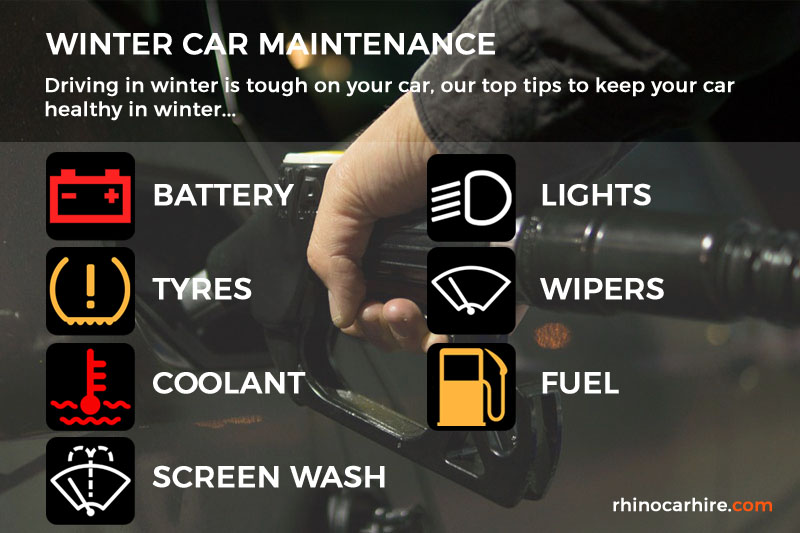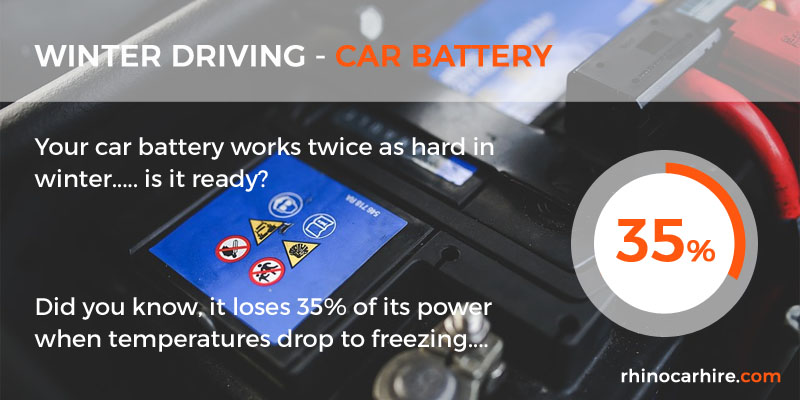We’ve covered
winter driving tips and techniques to help you drive in snow and ice and
what essentials you need when driving in winter, but what about your car itself? What can you do to your car to help it cope with the winter and what should you check regularly?

Battery
The cold weather puts a lot of extra strain on your cars battery. At zero degrees, a cars battery loses about 35% of its power, to compound the issue the battery has to work harder (can take up to twice as much current) to start the car in sub zero temperatures. Add to this that you’re likely to use more functions such as heaters (air, windscreen, seat, wing mirror, steering wheel), lights and wipers that drain battery power and it’s no wonder it’s most vulnerable in winter. Typically, car batteries have a 2-5 year shelf life for average use, however it’s wise to check your battery charge or have it checked before the winter sets in. A flat battery in the morning could spell the end of your journey before you’ve even set off.

Tyres
Whether you have regular tyres or
winter tyres it’s even more important during winter months to keep an eye on the tread depth and pressures. Whilst 1.6mm is the legal limit, it’s widely considered that at least 3mm is wise during winter. The tread depth (gauge) determines the ability of the tyre to clear water from between the tyre and the road. The less tread depth, the more likely you are to aquaplane.
Anti-Freeze
Anti-freeze is an additive that stops the water in the cars coolant system from freezing. Your car's engine relies on combustion which naturally generates an awful lot of heat and complex cooling systems run around the engine to the radiator(s) to keep the temperature of the engine within safe operating temperatures. If the coolant in the system freezes, it could result in the failure of the system and lead the engine to overheat causing significant and costly damage. It’s worth checking the coolant level manually as whilst
dash warning lights will let you know if the level is low, you’re better to top it up before it gets low. You should have the correct anti-freeze concentration in the system, you can check this manually with a simple tester kit, or have it checked at a garage.
Screen Wash
It may not sound like an important item, but keeping the windscreen clear to maintain visibility is not only vital from a safety perspective, it’s also a
winter driving law you may not be aware of. Keeping the screenwash topped up (you should also carry spare in your cars
winter driving essentials kit) is vital to ensure you can maintain a clear windscreen. Screen wash also has an anti freeze additive to reduce the freezing point, as frozen water in the screen wash will render it useless anyway. In winter conditions, you’ll use far more screen wash than usual, as much as 5 times the amount as your windscreen is exposed to salt on the roads.
Lights
You should check all of the lights are working as they should, it’s much more likely that you’ll be driving in the dark in winter and when visibility is poor we recommend you drive with lights on anyway (most modern cars have daytime running lights anyway). You can check your headlights easily by facing the car to a flat wall, you should notice the light’s directing to the left (nearside) as not to dazzle oncoming traffic (UK and other
countries that drive on the left). Poorly adjusted headlights can be dangerous to other drivers so if they are out of alignment, it’s important to get them checked. You should also manually check your rear lights, brake lights and indicators.
Wiper Blades
It’s easy to take wiper blades for granted, however you’d soon notice how vital they are to driving safely in winter and rain if they were to fail. Whilst it’s unlikely that the mechanism itself would fail, worn wiper blades won’t clear the windscreen anywhere near as effectively as fresh ones. If you see streaks when using the wipers, it’s likely they’ll need replacing. They are also easily damaged in winter if they freeze to the windscreen and are ‘pulled’ from the frozen screen. You should defrost the screen as best you can before switching the wipers on to minimise this risk.
Fuel
It’s wise to keep your tank at least half full when driving in winter. You never know if your journey may become much longer due to road closures or if you’re stuck in major congestion and running out of fuel is easily avoided by ensuring you don’t run the tank low. Whilst you may know where your
nearest petrol stations are to home, if you're out and about and have to change route, finding a petrol station may not be that easy.
Comments